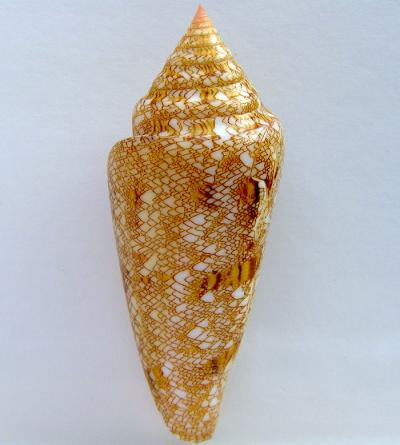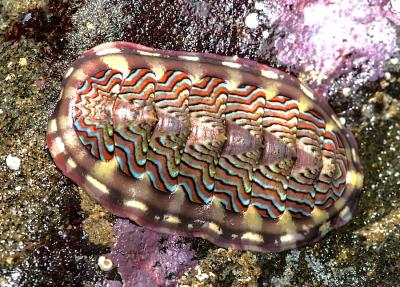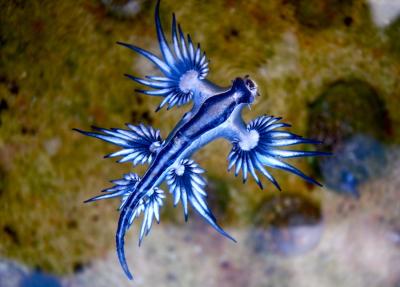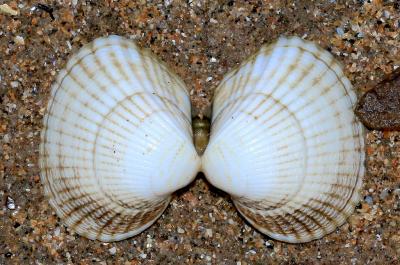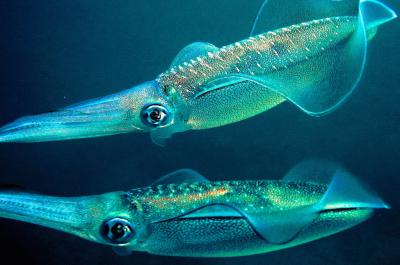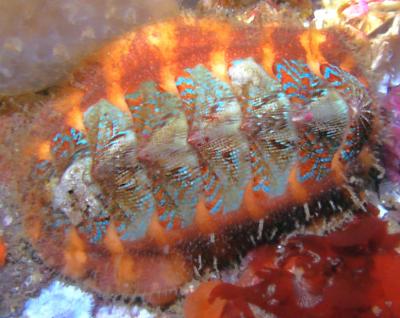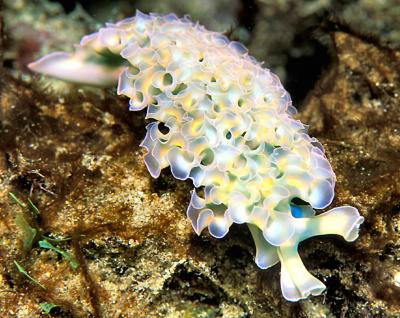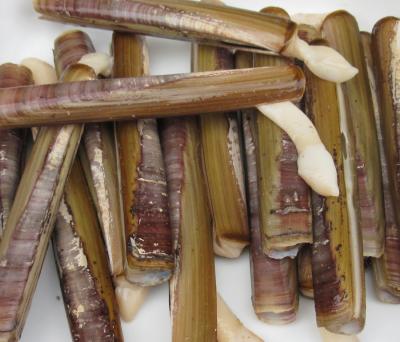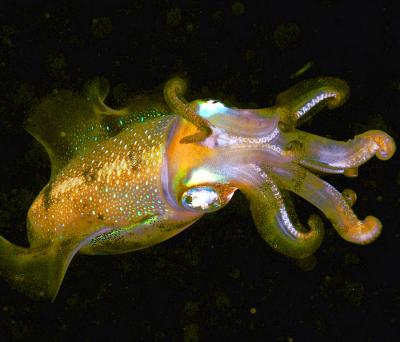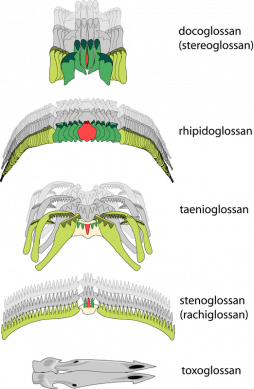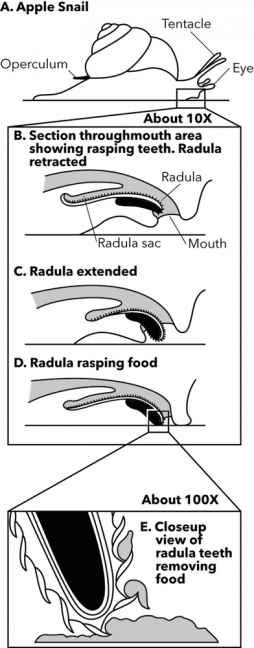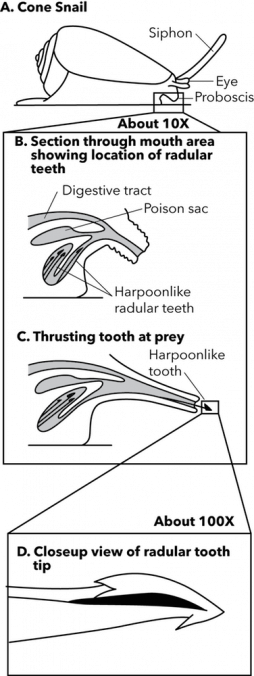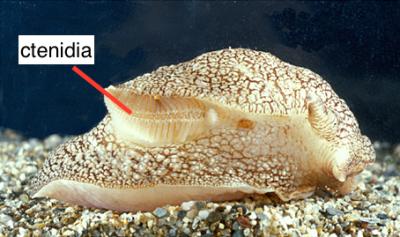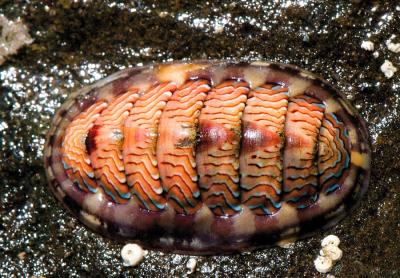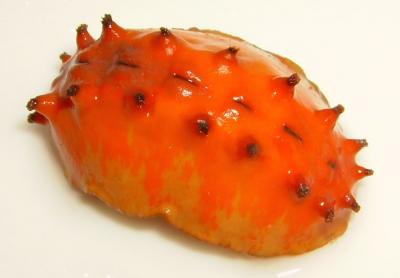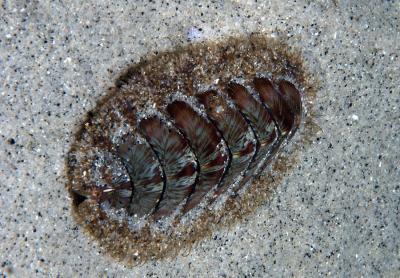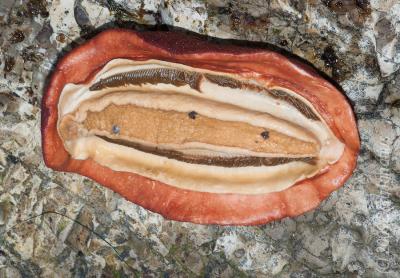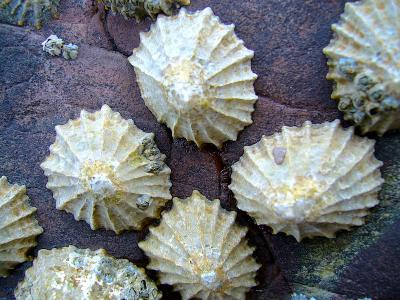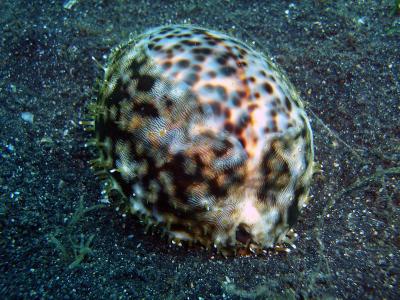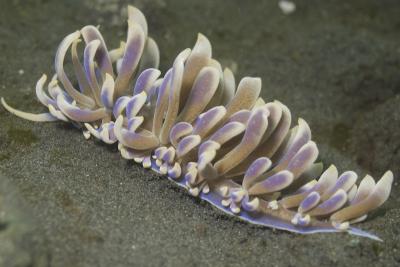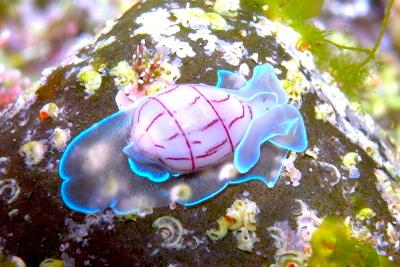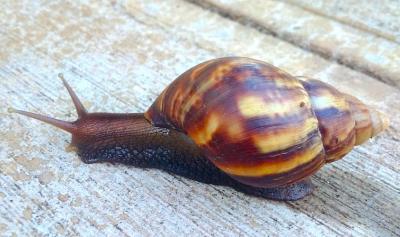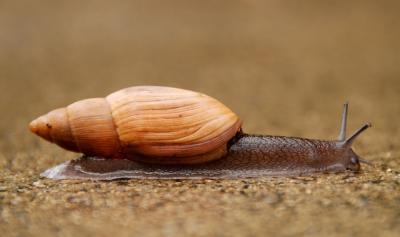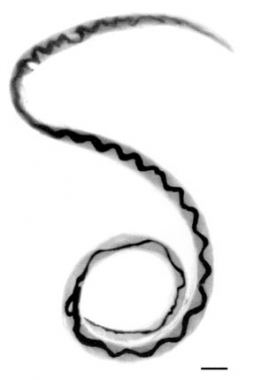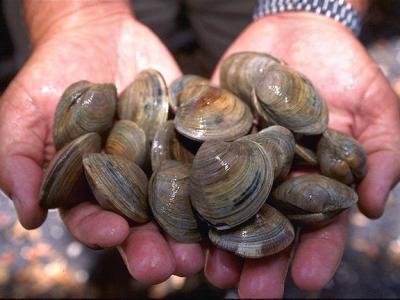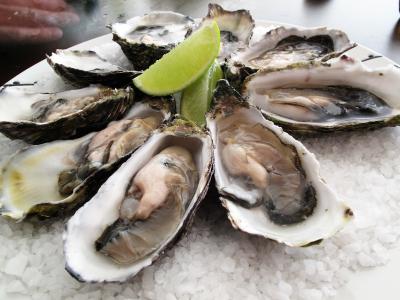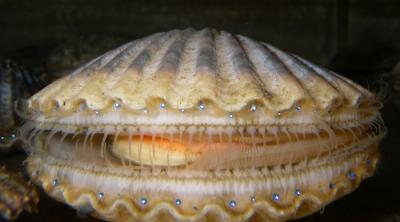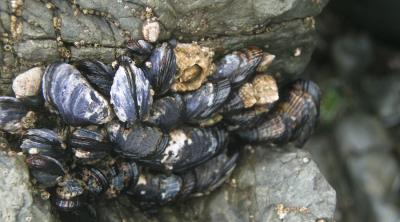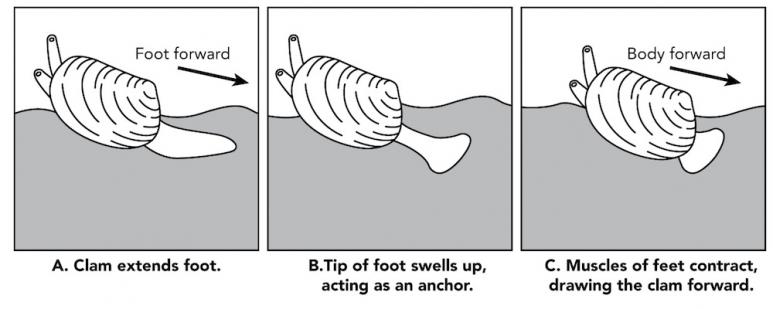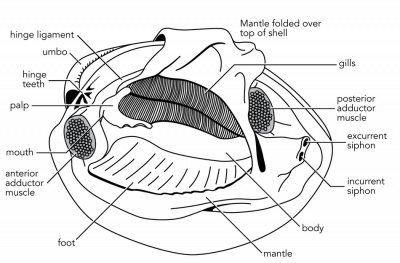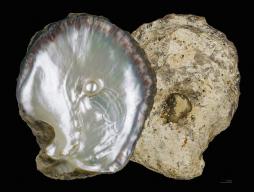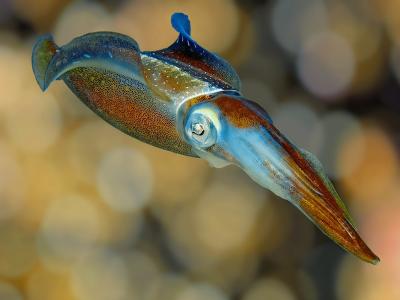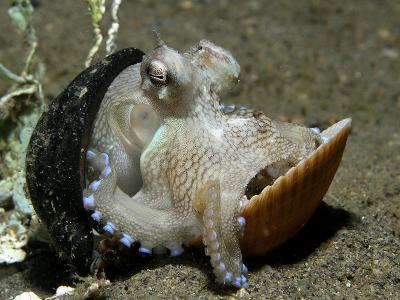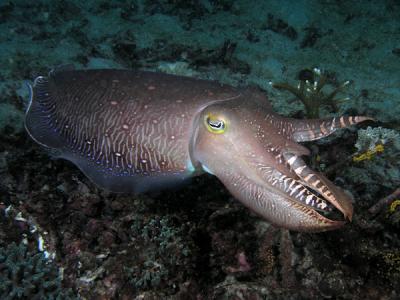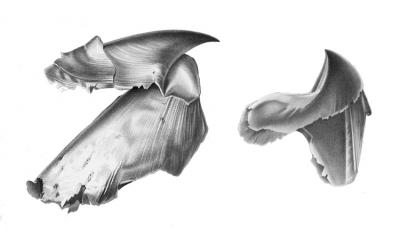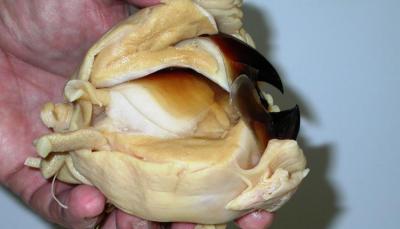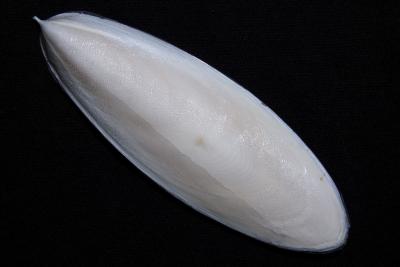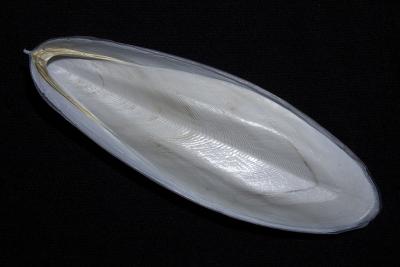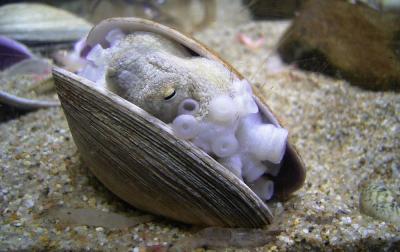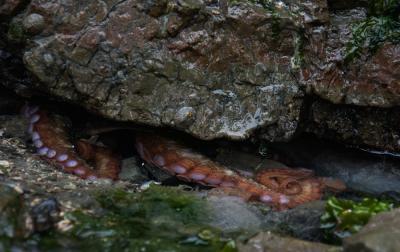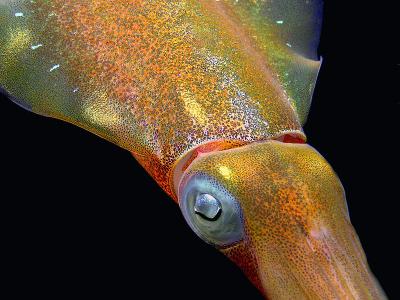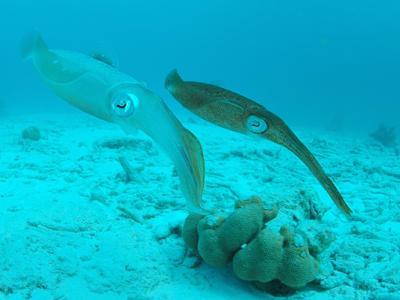Phylum Mollusca
Introduction to Phylum Mollusca
Fig. 3.52. Glory-of-the-sea snail (Conus gloriamaris) is prized by collectors for its ornate shell. Image courtesy of Jan Delsing, Wikimedia Commons
The phylum Mollusca is the second-largest animal phylum, with over 100,000 species. The molluscs include many familiar animals, including clams, snails, slugs, and squid, as well as some less familiar animals, like tusk shells and chitons (Fig. 3.51 A). Molluscs are found in nearly all freshwater and marine environments, and some are found also on land. The marine molluscs are probably the best-known and easily recognized members of the phylum. Many of their shells are highly valued by collectors. Shells from the glory-of-the-seas cone snail (Conus gloriamaris), for example, have gained prices as high as $10,000 (Fig. 3.52). We have learned much of what we know about this group from seashell collections.
Fig. 3.51. (A) Loki’s lined chiton (Tonicella lokii; class Polyplacophora)
Image courtesy of Jerry Kirkhart, Flickr
Fig. 3.51. (B) Blue dragon sea slug (Glaucus atlanticus; class Gastropoda)
Image courtesy of Sylke Rohrlach, Flickr
Fig. 3.51. (C) Cockle shells (class Bivalvia)
Image courtesy of S. Rae, Flickr
Fig. 3.51. (D) Bigfin reef squid (Sepioteuthis lessoniana; class Cephalopoda)
Image courtesy of Vincent C. Chen, Wikimedia Commons
There are four major groups within the phylum Mollusca:
- Class Polyplacophora consists of chitons, snail-like molluscs with eight-part overlapping scale shells (Fig. 3.51 A).
- Class Gastropoda are true snails and slugs (Fig. 3.51 B). They represent the most diverse class within phylum Mollusca with 60,000 to 80,000 extant species in marine, freshwater, and terrestrial habitats.
- Class Bivalvia are molluscs with hinged two-part shells (Fig. 3.51 C). Examples include clams, oysters, mussels, and scallops.
- Class Cephalopoda are molluscs with large heads, large eyes, and grasping tentacles (Fig. 3.51 D). Examples include octopus, squid, cuttlefish, and nautiloids.
A slug, a snail, a clam, and a squid do not look alike, but they are all molluscs. Although there is no single feature that all molluscs possess, three features are so common in molluscs that they are used to distinguish them from organisms in other phyla:
- All molluscs have a specialized foot used in digging, grasping, or creeping. The foot is a muscular organ modified into different forms in different molluscan classes (Fig. 3.53).
- Molluscs have a mantle or mass of soft flesh that covers the soft body and encloses the internal organs. In many species, the mantle produces a hard shell. Not all molluscs produce a shell.
- Many molluscs have a radula, which, in most species, is a rasp-like scraping organ used in feeding (Fig. 3.54). The word derives from the Latin root prefix radul- meaning scraper. Not all molluscs have a radula, but nothing like it is found in any other group of organisms. Bivalve molluscs lack a radula.
Fig. 3.53. (A) Red-flecked mopalia chiton (Mopalia spectabilis; class Polyplacophora) Image courtesy of Kirt L. Onthank, Wikimedia Commons Fig. 3.53. (B) Lettuce sea slug (Elysia crispata; class Gastropoda) Image courtesy of Laszlo Ilyes, Flickr
Fig. 3.53. (C) Razor clam (Ensis sp.; class Bivalvia)
Image courtesy of Man vyi, Wikimedia Commons
Fig. 3.53. (D) Bigfin reef squid (Sepioteuthis lessoniana; class Cephalopoda)
Image courtesy of Nick Hobgood, Wikimedia Commons
The foot is a muscular organ found in all molluscs. Polyplacophorans (chitons; Fig. 3.53 A) and gastropods (Fig. 3.53 B) have a single flat foot used for crawling. Some bivalves, such as clams, have a paddle-shaped foot adapted for digging into soft sediments (Fig. 3.53 C).
Because a sea slug’s stomach is in its foot, it is named Gastropoda, “stomach-foot” (from the Greek root words gastro meaning stomach and pod meaning foot; Fig. 3.53 B). The foot in octopus and squid is modified into many tentacles that are attached to the animal’s head (Fig. 3.53 D). That feature gave the class its name Cephalopoda (from the Greek root word cephal- meaning head), or the “head-foot” molluscs. Octopus and squid use their tentacles for moving and for grasping and holding the prey they capture for food.
In most molluscs, the mantle produces a hard protective shell. The mantle also creates patterns of color on a shell. The shell is an exoskeleton, even though it is completely surrounded by soft tissue in some molluscs. The shell is continually produced and grows with the animal. Chitons are in the class Polyplacophora (poly meaning many; placo meaning plate or shell; phora meaning bearing). A chiton’s mantle produces eight shell-like plates that cover the body. Joints between the plates allow the chiton to curl up in a ball and to move flexibly (Figs. 3.51 A and 3.53 A). The class of molluscs called Bivalvia (from Latin root words bi- meaning two and -valv meaning folding door) includes clams, oysters, mussels, and scallops. Bivalves produce two shells that are hinged at the top (Fig. 3.49 B). The mantle of snails (gastropods) produces a single shell in a spiral shape (Fig. 3.49 C). The mantle itself cannot be seen because it is on the inner surface of the shell. In some gastropods, such as the cowries, the mantle extends over the shell, keeping the shell shiny and new in appearance. In other gastropods, like the sea hares, and in some cephalopods, like the squid and the octopus, the shell is very small and the mantle covers the shell completely (Fig. 3.49 D). The nudibranchs, or sea slugs (nudi- meaning naked, -branch meaning gill), are gastropods that don’t produce a shell, so these animals are all soft-bodied (Fig. 3.49 E). The chambered nautilus is one cephalopod that secretes an external shell. Squid and cuttlefish produce internal shells that are contained within the mantle, and octopus do not produce shells at all.
Fig. 3.54. Diversity of radula forms in gastropod molluscs Image courtesy of Debivort, Wikimedia Commons Fig. 3.55. Herbivorous gastropod radula scraping food Image by Byron Inouye Fig. 3.56. Carnivorous gastropod radulas are specialized harpoon structures Image by Byron inouye
The mouth structures of many molluscs include a specially adapted rasp-like tongue called a radula. The radula is a hard ribbon-shaped structure covered in rows of teeth. Herbivorous snails have a mouth with a radula of usually five to seven complex teeth. There is a great diversity of radula forms in the mollusca (Fig. 3.54). The snail uses its radula like a file, rasping it back and forth over the substrate to scrape off small bits of food (Fig. 3.55). As radular teeth wear down or break off, new teeth are formed to replace them. The tooth patterns of snail radulas are distinctive to species, and scientists can identify snails by looking at their radulas. Some radulas are highly specialized. A group of gastropods called cone snails are carnivorous (meat-eating) hunters that produce venom in glands near the mouth. Their radulas are shaped into long, hollow teeth, which they thrust one at a time into their prey like harpoons (Fig. 3.56). A barbed radular tooth fires through the proboscis, which is an extension of the mouth. It pierces the prey, paralyzing it with venom and preventing its escape. The cone snail “swallows” the prey by engulfing it with its proboscis. In this way cones stalk and capture worms, molluscs, and even fish. Some cones produce a poison strong enough to kill humans who handle them carelessly. Their poison is a neurotoxin that attacks and destroys nerves.
Fig. 3.57. Molluscs breathe using gills called ctenidia as shown in the sea slug, Pleurobranchaea meckelii. Image adapted from Heike Wägele & Annette Klussmann-Kolb, BioMed Central
Molluscs breathe with gills called ctenidia that sit in a cavity between the mantle and body mass (Fig. 3.57). In some molluscs, most notably bivalves like oysters and mussels, the ctenidia are also used as filter feeding apparatus to strain particulate food from the water. Molluscs have a complete digestive tract surrounded by a small coelom. The molluscan circulatory system is composed of a series of blood sinuses or cavities, rather than closed, discrete vessels. This is referred to as an open circulatory system. Molluscs display a large diversity of nervous systems, from the rudimentary nervous system of the brainless bivalves to the complex systems of the cephalopods, who have well-developed brains and are considered the most intelligent of invertebrates.
Class Polyplacophora
Fig. 3.58. (A) Lined chiton (Tonicella lineata) Image courtesy of Jerry Kirkhart, Flickr Fig. 3.58. (B) Butterfly chiton (Cryptoconchus porosus) Image courtesy of Graham Bould, Wikimedia Commons
Fig. 3.58. (C) Wood chiton (Mopalia lignosa)
Image courtesy of Ed Bierman, Flickr
Fig. 3.58. (D) Underside of gumboot chiton (Cryptochiton stelleri)
Image courtesy of Barb Ignatius, Flickr
Chitons (Polyplacophora) are basal relative to other extant molluscs (Fig. 3.58). Their soft bodies are covered with a series of eight shell plates. The joints between these shell plates enable to chitons to roll up for protection. Chitons are mobile and contract their muscular foot in waves to move about. The primarily herbivorous chitons have a well-developed radula. Their nervous system is a series of ladder-like nerves and only a few species have poorly developed ganglia. Chitons are found only marine environments. They are most commonly found in tide pools and rocky intertidal zones. Chitons can tolerate the harsh conditions of these habitats where ocean and land meet.
Class Gastropoda
Fig. 3.59. (A) Common limpets (Patella vulgata) Image courtesy of Tango22, Wikimedia Commons Fig. 3.59. (B) Tiger cowrie (Cypraea tigris) with soft mantle extended over shell Image courtesy of Samuel Chow, Flickr
Fig. 3.59. (C) An aeolid nudibranch
Image courtesy of Elias Levy, Flickr
Fig. 3.59. (D) Red-lined bubble snail (Bullina lineata)
Image courtesy of Sylke Rohrlach, Flickr
Gastropods are the most diverse group of molluscs (Fig. 3.59). The ones we usually think of are snails and slugs. Most gastropods have a calcareous shell protecting the soft-bodied animal inside. Some gastropods, such as sea slugs, sea hares, and garden slugs, lack a shell or have a reduced shell buried in the folds of their mantle. Most creep about on a flattened foot, but some swim, using extended folds of their mantle as fins. Most snails and terrestrial slugs are herbivorous. They use their radula to scrape algae from surfaces (Fig. 3.55) or to pierce plant parts. For this reason, gardeners consider snails and slugs to be pests. Some gastropods are carnivores, stalking other snails, worms, and fish for food (Fig. 3.56). The colorful and striking nudibranchs contain many carnivorous specialists. Many nudibranchs feed on only one type of sponge; their body coloration and their eggs are patterned to blend in with their prey. Other gastropods use their radula and acidic secretions to bore holes in shells and prey on other molluscs.
Fig. 3.60. (A) Giant East African land snail (Achatina fulica) Image courtesy of Dr. Scot Nelson, University of Hawaiʻi College of Tropical Agriculture and Human Resources, Department of Tropical Plant and Soil Sciences Fig. 3.60. (B) Terrestrial cannibal snail (Euglandina rosea) Image courtesy of Dylan Parker, Wikimedia Commons
Fig. 3.41. (E) Rat lungworm (Angiostrongylus cantonensis), a nematode parasite that can cause meningitis
Photo courtesy of Lindo et al. 2002 originally published in Emerging Infectious Diseases
In the Hawaiian Islands, the terrestrial cannibal snail (Euglandina rosea; Fig. 3.60 A) was introduced to control the giant East African land snail (Achatina fulica; Fig. 3.60 B). The giant East African land snail is considered to be an agricultural pest and is also known to be a carrier of the parasitic nematode rat lungworm (Angiostrongylus cantonensis; Fig. 3.41 E) that can cause the brain disease meningitis. Unfortunately, the cannibal snails also predated native land snails, nearly driving them to extinction.
Marine and freshwater gastropods breathe using ctenidia or gills. In many of these gastropods the ctenidia are protected within the mantle cavity. In the nudibranchs (nudi- meaning naked, -branch meaning gill), these ctenidia are exposed on the outside of the animal’s body. This distinctive trait makes nudibranchs an easily identifiable group of molluscs. Terrestrial slugs and snails, by contrast are primarily in a subgroup known as the pulmonates that actually have a mantle cavity that has become connected to the circulatory system (vascularized) to function as a lung.
Gastropods move by contracting their muscular foot in a series of waves to creep forward. Many gastropods secrete mucus (so called “snail trails”) to help facilitate movement. These trails also provide chemical communication among gastropods. The cannibal snail, for example, tracks its prey by following the mucus trail left behind. The gastropod nervous system includes bodily nerves and anterior ganglia with relatively sophisticated sensory systems, including light receptors and well developed chemosensory abilities.
Class Bivalvia
Fig. 3.61. (A) Hard-shell clams (Mercenaria mercenaria) Image courtesy of Ken Hammond/Gef Flimlin's Hands, United States Department of Agriculture (USDA) Fig. 3.61. (B) Pacific oysters (Crassostrea gigas) prepared for raw consumption with one shell removed Image courtesy of gautsch., Flickr
Fig. 3.61. (C) Atlantic bay scallop (Argopecten irradians)
Image courtesy of Rachael Norris and Marina Freudzon, Wikimedia Commons
Fig. 3.61. (D) California mussels (Mytilus californianus) with different species of barnacles and gastropod snails
Image courtesy of Sharon Mollerus, Flickr
The bivalve molluscs get their name from the two door-like valves or shells that make up their exoskeleton (Fig. 3.61). Foot size varies among marine bivalves. Clams have a muscular hatchet-shaped foot for moving about and for burrowing in mud or sand (Fig. 3.62). By contrast, an oyster’s or a mussel’s foot is small because these animals attach themselves to hard objects early in life and do not move around. Scallops don’t use their small foot to move around either. They swim in short bursts by jet propulsion, clapping their shells together and forcing water out the rim.
Fig. 3.62. A clam using its foot to move Image by Byron Inouye (modified from Pearse and Buchsbaum, 1982)
Fig. 3.63. Diagram of the internal anatomy of a clam
Image by Byron Inouye
Bivalves are more enclosed by their shells than other molluscs. Water enters and leaves a bivalve by way of two tubes called siphons. One siphon takes in water while the other expels water and waste. The water taken in contains oxygen and food particles. Most bivalve species acquire energy and nutrients through filter feeding. Filter feeding or suspension feeding is the process of ingesting water and filtering out food particles. Invertebrate examples of filter feeders include sponges, corals, and bivalve molluscs. As water is taken into the body, it flows across the gills. Oxygen (O2) and carbon dioxide (CO2) are exchanged between the circulatory system and the water. Mucus on the gills traps microscopic food particles, and tiny hairlike cilia move the food-laden mucus toward the mouth. Liplike structures called palps help sort the food and direct it into the mouth. Bivalves do not have a radula (Fig. 3.63). The food suspended in mucus moves through the digestive organs, which break it down and absorb it.
Bivalves such as clams, oysters, and scallops are valuable as food. They make up a major share of the marine invertebrate seafood industry. Bivalves should not be eaten when the water in which they grow becomes polluted with chemicals or disease organisms. At certain times of year, microscopic organisms called dinoflagellates multiply rapidly in nearshore waters. Toxic substances produced by dinoflagellates can concentrate in the clams and oysters that use them as food. Although the bivalves are not harmed, the toxin can attack the nervous system of humans who eat the tainted shellfish. Toxic shellfish poisoning can be fatal to humans.
Fig. 3.64. Layers of nacre inside a black-lip pearl oyster (Pinctada margaritifera) shell with all living tissue removed. A pearl is small particle lodged between the mantle and shell that becomes covered in a nacreous layer. Image courtesy of Didier Descouens, Muséum de Toulouse
In some bivalves, such as oysters, mantle tissue secretes nacre (pronounced “NAY ker”), a pearly substance that coats any irritating foreign particles that lodge between the mantle and the shell (Fig. 3.64). A pearl forms as coats of nacre build up around the foreign particle. Cultured pearls used in jewelry are produced when farm-raised oysters are intentionally seeded with foreign particles to stimulate the production of nacre. The cost of pearls varies with size, color, and luster. Before plastic came into use, the shells of bivalves were commonly used to make buttons. The material known as mother-of-pearl is harvested from the nacre of mollusc shells.
Class Cephalopoda
The cephalopods are molluscs with large heads and tentacles. Examples of cephalopod molluscs include squid, octopus, cuttlefish, and nautilus (Fig. 3.65). Most cephalopods are relatively small. But the giant octopus (Enteroctopus sp.), which lives along the west coast of the United States, can grow to 1.5 m or more. The giant squid, the largest invertebrate, reaches lengths of 15 m.
Fig. 3.65. (A) Caribbean reef squid (Sepioteuthis sepioidea) Image courtesy of Betty Willis, Wikimedia Commons Fig. 3.65. (B) The coconut octopus (Amphioctopus marginatus) has been observed carrying coconut shells and mollusc shells while moving along the seafloor. Image courtesy of Nick Hobgood, Wikimedia Commons
Fig. 3.65. (C) Cuttlefish (Sepia sp.)
Image courtesy of Nick Hobgood, Wikimedia Commons
Fig. 3.65. (D) Palau nautilus (Nautlius belauensis)
Image courtesy of Manuae, Wikimedia Commons
The foot in this group has specialized by dividing into arms that are attached to the head, thus the name cephalopod, meaning head-foot. Like other molluscs, cephalopods have a mantle and mantle cavity that houses the respiratory ctenidia. The mantle cavity is also used to take in and rapidly expel water to facilitate the jet propulsion swimming mode of most cephalopods. When the mantle closes forcefully, seawater ejected through the siphon propels the animal in short bursts. Both squid and octopus change course by redirecting their siphon. They steer by pressing their arms together and can use their speed to elude an attacking predator. They can also squirt ink from the ink sac into the water, creating an ink cloud for camouflage and confusing the predator. Deep-water cephalopods can even produce luminescent ink.
Fig. 3.66. (A) Drawing of beak parts Image courtesy of L. Joubin, Wikimedia Commons Fig. 3.66. (B) Dissected beak shown with muscle attachments Image courtesy of the Smithsonian Institution
Cephalopods also have a small radula, but the radula is not used for food capture. In the mouth of the squid is a beak shaped much like the beak of a parrot. Figure 3.66 shows the giant squid (Architeuthis sp.) beaks . The beak is not part of the shell but a separate tooth-like structure. When a squid catches prey, such as a fish, it bites off and swallows chunks of it. The octopus spends most of its time crawling around the bottom, capturing prey with its arms and the suction cups lining the inner surfaces of the arms. After capturing its prey, the octopus bites it, injecting both a poison and digestive enzymes. The enzymes soften the food before the octopus sucks it into its stomach for further digestion. The tiny blue-ringed octopus of the Indo-Pacific region has developed particularly strong venom that is used for defense as well. The venom of this octopus is potent and has been implicated in the deaths of several humans who unknowingly picked up the little octopus and received a defensive bite.
Fig. 3.67. The nautilus (Nautilus spp.) has geometric chambers it uses for buoyancy, as shown in this shell that has been cut in half. Image courtesy of Chris73, Wikimedia Commons Fig. 3.68. The pen in a squid acts to keep the body rigid. Image courtesy of L. Joubin, Wikimedia Commons
Most cephalopods do not have external shells. The nautilus is the only living exception, having a complete, well-developed shell separated into geometrically precise chambers. (Figs. 3.65 D and 3.67). These chambers contain gas that the animal produces to regulate changes in buoyancy when it moves to shallower or deeper water. The amount of gas in the chamber changes, so that the nautilus rests, rises, or sinks. The squid has an internal remnant of a shell, called a pen, that looks like a sheet of thick plastic (Fig. 3.68). This long, thin shell helps support the body. The cuttlefish, a close relative of the squid, has a harder, more brittle plate, called a cuttlebone (Fig. 3.69). The cuttlebone in cuttlefish helps to keep the body rigid. A cuttlebone is made of calcium carbonate secreted by the animal; in composition it is similar to the shells of other molluscs. Gas moving in and out of chambers in the cuttlebone lets the cuttlefish move up and down in the water. The octopus has no shell at all. Its only hard body part is its beak, which, as in the squid, is not a remnant of the shell. Because an octopus has no hard skeleton, its soft body can squeeze through tiny openings in a reef and hide in crevices or between rocks (Fig. 3.70). Octopuses in aquariums are notorious for their ability to escape.
Fig. 3.69. (A) Dorsal view of a cuttlebone Image courtesy of Mariko Goda, Wikimedia Commons Fig. 3.69. (B) Ventral view of a cuttlebone Image courtesy of Mariko Goda, Wikimedia Commons
Fig. 3.70. (A) Octopus hiding in a mollusc shell
Image courtesy of Daiju Azuma, Flickr
Fig. 3.70. (B) Large octopus hiding under a rock shelf
Image courtesy of Andrew E. Russell, Flickr
Cephalopods are also masters of camouflage, using pigments in their skin cells to quickly change their skin color to blend into their surroundings (Fig. 3.71). These skin cells, called chromatophores, contain an elastic sac filled with pigment. The cells are attached to a set of muscle cells. When the muscle cells contract, they pull the chromatophore out flat, spreading the pigment over a larger area and making the skin darker. When the chromatophore is smaller, the skin appears lighter. Chromatophores can change shape very rapidly, producing a pulsating pattern of complex color changes. Squid and cuttlefish also have chromatophores, which they use to communicate with fellow squid. These cephalopods can also wave paddle-shaped fins to move slowly forward or backward. The complex communication systems of cephalopods emphasize the highly developed nervous systems of these animals. Unlike other molluscs, cephalopods have fairly well-developed brains and have image-forming eyes similar to those of vertebrates (with the exception of the nautilus that has a more basic eye). Octopuses have been trained in captivity and even demonstrate rudimentary learning abilities.
Fig. 3.71. (A) A reef cuttlefish (Sepia latimanus) changing from darker pink coloration to light pink-white coloration Image courtesy of Nick Hobgood, Wikimedia Commons
Fig. 3.71. (B) Chromophores visible on Caribbean reef squid (Sepioteuthis sepioidea)
Image courtesy of Betty Willis, Wikimedia Commons
Fig. 3.71. (C) Two Caribbean reef squid (Sepioteuthis sepioidea) exhibiting chromatophore color changes
Image courtesy of Clark Anderson, Wikimedia Commons


